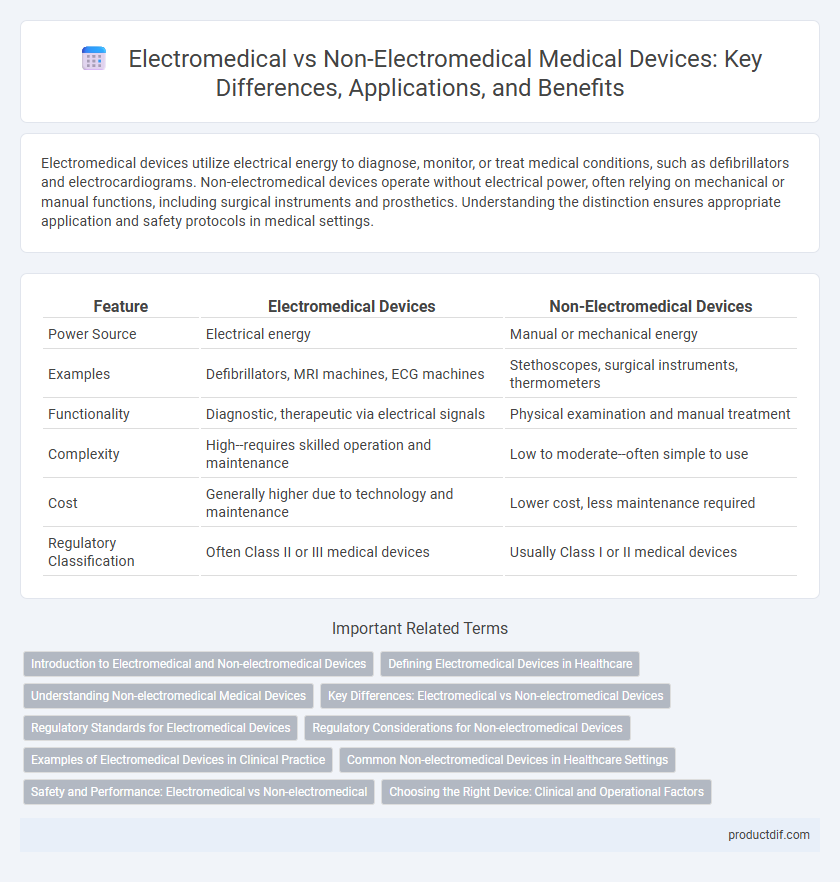Electromedical devices utilize electrical energy to diagnose, monitor, or treat medical conditions, such as defibrillators and electrocardiograms. Non-electromedical devices operate without electrical power, often relying on mechanical or manual functions, including surgical instruments and prosthetics. Understanding the distinction ensures appropriate application and safety protocols in medical settings.
Table of Comparison
| Feature | Electromedical Devices | Non-Electromedical Devices |
|---|---|---|
| Power Source | Electrical energy | Manual or mechanical energy |
| Examples | Defibrillators, MRI machines, ECG machines | Stethoscopes, surgical instruments, thermometers |
| Functionality | Diagnostic, therapeutic via electrical signals | Physical examination and manual treatment |
| Complexity | High--requires skilled operation and maintenance | Low to moderate--often simple to use |
| Cost | Generally higher due to technology and maintenance | Lower cost, less maintenance required |
| Regulatory Classification | Often Class II or III medical devices | Usually Class I or II medical devices |
Introduction to Electromedical and Non-electromedical Devices
Electromedical devices utilize electrical energy for diagnosis, monitoring, or therapy, including equipment such as ECG machines, defibrillators, and MRI scanners. Non-electromedical devices rely on mechanical or manual principles without electrical components, examples being surgical instruments, thermometers, and orthopedic braces. Understanding the functional distinctions between these two categories is essential for device classification and regulatory compliance in healthcare.
Defining Electromedical Devices in Healthcare
Electromedical devices in healthcare utilize electrical energy to diagnose, monitor, or treat medical conditions, encompassing equipment such as ECG machines, defibrillators, and ultrasound devices. These devices rely on electrical signals to perform precise medical functions, offering enhanced accuracy and real-time data compared to non-electromedical devices. Understanding the distinct role of electromedical devices is crucial for advancing diagnostic capabilities and improving patient outcomes in modern clinical settings.
Understanding Non-electromedical Medical Devices
Non-electromedical medical devices are instruments or apparatuses used in healthcare that do not rely on electrical energy for their primary function, such as surgical tools, thermometers, and manual diagnostic equipment. These devices are crucial for patient care, often designed for durability, sterility, and ease of use without electrical components. Understanding the material composition, sterilization methods, and ergonomic design of non-electromedical devices is essential for ensuring safety and effectiveness in clinical environments.
Key Differences: Electromedical vs Non-electromedical Devices
Electromedical devices, such as MRI machines and pacemakers, utilize electrical energy to diagnose, monitor, or treat medical conditions, whereas non-electromedical devices, like surgical instruments and prosthetics, function without electrical components. Key differences include the reliance on electrical power, complexity of technology, and regulatory requirements due to potential electrical hazards. Electromedical devices often require specialized maintenance and calibration to ensure safety and accuracy in clinical settings.
Regulatory Standards for Electromedical Devices
Electromedical devices must comply with stringent regulatory standards such as IEC 60601, which ensures electrical safety, performance, and electromagnetic compatibility to protect patients and operators. In contrast, non-electromedical devices generally follow less rigorous guidelines, focusing more on material safety and mechanical performance. Compliance with regulations like the FDA's 21 CFR Part 820 and EU MDR 2017/745 is critical for market approval and ongoing post-market surveillance of electromedical devices.
Regulatory Considerations for Non-electromedical Devices
Non-electromedical devices, classified under medical devices without electrical components, require strict compliance with regulatory frameworks such as the FDA's 21 CFR Part 820 and the EU MDR 2017/745, focusing on material safety, biocompatibility, and mechanical integrity. Risk management standards like ISO 14971 are critical for ensuring the safety and effectiveness of these devices, emphasizing hazard identification and control without the complexities of electromagnetic interference. Documentation for non-electromedical devices prioritizes precise labeling, performance validation, and post-market surveillance to meet both national and international regulatory obligations.
Examples of Electromedical Devices in Clinical Practice
Electromedical devices in clinical practice include electrocardiograms (ECG) for heart monitoring, defibrillators for emergency cardiac care, and ultrasound machines for imaging soft tissues. These devices utilize electrical energy to diagnose, monitor, or treat medical conditions, providing real-time data and therapeutic interventions. Common non-electromedical devices contrast by relying on mechanical or manual operation, lacking electronic components integral to electromedical technology.
Common Non-electromedical Devices in Healthcare Settings
Common non-electromedical devices in healthcare settings include surgical instruments, diagnostic tools like stethoscopes, and patient care items such as thermometers and blood pressure cuffs. These devices operate without electrical power, relying on mechanical or manual functions to assist in diagnosis, treatment, and monitoring. Their simplicity, reliability, and cost-effectiveness make them essential components in medical practice alongside advanced electromedical equipment.
Safety and Performance: Electromedical vs Non-electromedical
Electromedical devices rely on electrical energy to diagnose, monitor, or treat patients, requiring stringent safety protocols to prevent electrical hazards and ensure reliable performance. Non-electromedical devices, typically mechanical or manual, emphasize durability and material biocompatibility, minimizing risks associated with physical malfunction or contamination. Regulatory standards like IEC 60601 for electromedical and ISO 13485 for all medical devices govern safety and performance to protect patient health and maintain device efficacy.
Choosing the Right Device: Clinical and Operational Factors
Selecting the appropriate medical device requires evaluating clinical efficacy, patient safety, and operational efficiency. Electromedical devices, which use electrical energy for diagnosis or treatment, often offer advanced features like real-time monitoring and automated functions, enhancing precision and workflow integration. Non-electromedical devices, while typically simpler and more cost-effective, may lack sophisticated capabilities but remain essential for basic diagnostic and therapeutic applications where electrical components are unnecessary.
Electromedical vs Non-electromedical Infographic

 productdif.com
productdif.com